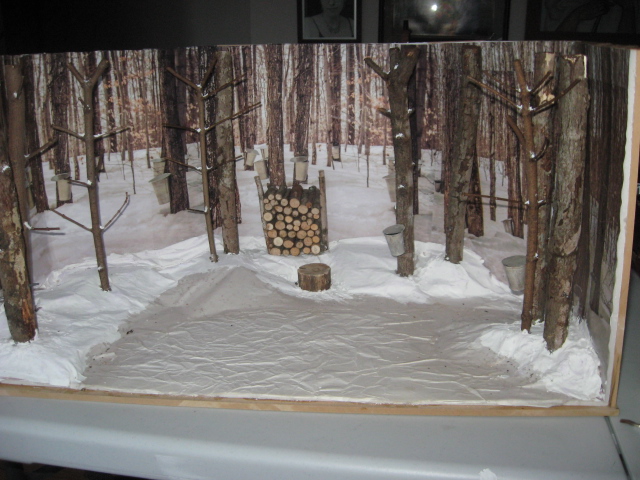This morning, the diorama was delivered to its new home, Kings Landing Historical Settlement in New Brunswick, Canada. It is currently ensconced in a display case in the Visitor Reception Centre at the site, ready for Maple Sugaring Weekends 2024, on March 9-10 and 16-17. This year marks the Settlement's 50th Anniversary.
Here is the overall view of the finished diorama, with the lights on. I'm very pleased with how it turned out, and I think the staff at the Landing are too. I've been a volunteer there now for 18 years, and my family has always enjoyed visiting. This was Marilyn's and my commemoration of the museum's anniversary.
The centre left holds the sap vat, with its canvas cover, weighted at the four corners by stones sewn to the fabric. The sap workers have just emptied the sap cans, and are preparing to add the sap to the evaporating pans. The sled is pulled by humans, as this is a family sugar bush operation, not a commercial one, which would use a horse-drawn sled.
Beyond the centre, at the edge of the scene, you see a tree with two sap buckets. Behind it on the snow lies an empty barrel, used to haul water to wash the equipment with, and to make tea for the workers. The large copper cauldron, which is also used to boil down the sap, has been cleaned and is draining against some felled tree trunk sections. Beyond that is the woodpile, and the chopping block with its axe and wedges.
On the other side, the sap boilers are finishing their tea break, using the chest they employ to haul the necessary tools and equipment into the woods as their table. On the stump is a hydrometer in its case, while the sieve, skimmer and scraper are on top of the rock. The small shovel for the ashes leans against the rock. The fireplace was built of commercial miniature bricks, while the pans, smoke hood and damper are made of faux-finished cardboard.
As mentioned before, Marilyn and I used a series of how-to articles published in Nutshell News in April, June and July of 1992. The author of the articles was Ruth Armstrong, a wonderful metalworker. As we were not metalworkers, we used cardboard and cellulose clay to create the copper and metal sheet items. I enjoy working with faux finishes, and this scene allowed me to indulge that fascination. The only item(s) not made by us were the tea pot (plastic), the two wooden buckets at the back of the scene, and the wooden barrel lying on its side.
Now I have to tidy my work space, and Marilyn is going to work on inventory for the NB Miniature and Doll Show 2024, to be held in early May. When sugaring off starts, we know Spring won't be that far away....









